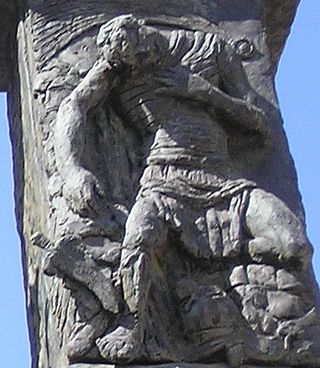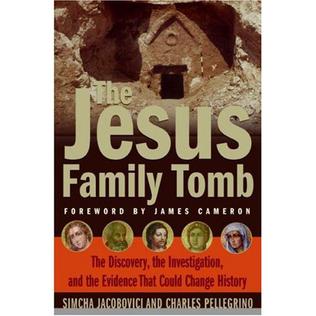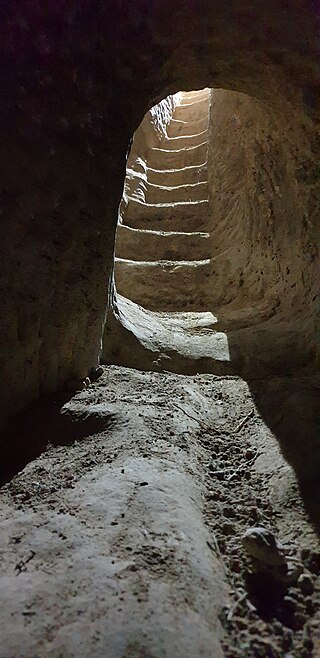
Bar Kokhba weights are weights that were used during the Bar Kokhba revolt. Of the seven weights found so far, six weights originated from the antiquities market, and only one was found in an archeological survey.

Bar Kokhba weights are weights that were used during the Bar Kokhba revolt. Of the seven weights found so far, six weights originated from the antiquities market, and only one was found in an archeological survey.
Four weights are from the Bar Kokhba period, on which the inscription is inscribed using the square Hebrew alphabet.
One lead weight was found in 1987 by Yair Zoran in an underground hideout in Horvat Alim near Beit Guvrin. [1] The weight was published by Amos Kloner. The weight is 803 grams (1.770 lb), decorated with a stylish rosette and surrounded by a Hebrew inscription. [2] Kloner mentioned in his article that an additional weight was bought in 1967 for the Eretz Israel Museum but was stolen in 1976. It weighed about 400 grams (14 oz). Until the weight was found in 1987, it was not known that this weight belonged to the Bar Kokhba period. Another two weights that Kloner mentions were published by Baruch Lipschitz, one of them weighed 210 grams (7.4 oz), while the other weighed 205 grams (7.2 oz).
Three other weights originating in the antiquities market bear an inscription in the Paleo-Hebrew alphabet.
In 2001, Robert Deutsch published another weight which weighed 421 grams (14.9 oz). [3] It is inscribed in the Ancient Hebrew alphabet: Shimon, Son of Kosba, Prince of Israel. It was purchased by Shlomo Moussaieff. In 2003, Deutsch published another weight weighing 215 grams (7.6 oz), with an inscription in the ancient Hebrew alphabet: Shimon, Prince of Israel. [4]

Shekel or sheqel is an ancient Mesopotamian coin, usually of silver. A shekel was first a unit of weight—very roughly 11 grams —and became currency in ancient Tyre and Carthage and then in Hasmonean Judea.

The Bar Kokhba revolt was a large-scale armed rebellion initiated by the Jews of Judea, led by Simon bar Kokhba, against the Roman Empire in 132 CE. Lasting until 135 or early 136, it was the third and final escalation of the Jewish–Roman wars. Like the First Jewish–Roman War and the Second Jewish–Roman War, the Bar Kokhba revolt resulted in a total Jewish defeat; Bar Kokhba himself was killed by Roman troops at Betar in 135 and the Jewish rebels who remained after his death were all killed or enslaved within the next year.
The Paleo-Hebrew script, also Palaeo-Hebrew, Proto-Hebrew or Old Hebrew, is the writing system found in Canaanite and Aramaic inscriptions, including pre-Biblical and Biblical Hebrew, from southern Canaan, also known as the biblical kingdoms of Israel (Samaria) and Judah. It is considered to be the script used to record the original texts of the Bible due to its similarity to the Samaritan script; the Talmud states that the Samaritans still used this script. The Talmud described it as the "Livonaʾa script", translated by some as "Lebanon script". However, it has also been suggested that the name is a corrupted form of "Neapolitan", i.e. of Nablus. Use of the term "Paleo-Hebrew alphabet" is due to a 1954 suggestion by Solomon Birnbaum, who argued that "[t]o apply the term Phoenician [from Northern Canaan, today's Lebanon] to the script of the Hebrews [from Southern Canaan, today's Israel-Palestine] is hardly suitable". The Paleo-Hebrew and Phoenician alphabets are two slight regional variants of the same script.

Betar, also spelled Beitar, Bethar or Bether, was an ancient Jewish town in the Judaean Mountains. Continuously inhabited since the Iron Age, it was the last standing stronghold of the Bar Kokhba revolt, and was destroyed by the Imperial Roman Army under Hadrian in 135 CE.

David Ussishkin is an Israeli archaeologist and professor emeritus of archaeology.

Tel Maresha is the tell of the biblical Iron Age city of Maresha, and of the subsequent, post-586 BCE Idumean city known by its Hellenised name Marisa, Arabised as Marissa (ماريسا). The tell is situated in Israel's Shephelah region, i.e. in the foothills of the Judaean Mountains, about 2 kilometres (1.2 mi) southeast of Beit Gubrin.

The Talpiot Tomb is a rock-cut tomb discovered in 1980 in the East Talpiot neighborhood, five kilometers south of the Old City in East Jerusalem. It contained ten ossuaries, six inscribed with epigraphs, including one interpreted as "Yeshua bar Yehosef", though the inscription is partially illegible, and its translation and interpretation is widely disputed. The tomb also yielded various human remains and several carvings.

The Jesus Family Tomb: The Discovery, the Investigation, and the Evidence That Could Change History (ISBN 0061192023) is a controversial book by Simcha Jacobovici and Charles R. Pellegrino published in February 2007. It tells the story of the discovery of the Talpiot Tomb on Friday March 28, 1980 and makes an argument that it is the tomb of Jesus Christ and his family.

Beit She'arim necropolis is an extensive necropolis of rock-cut tombs near the remains of the ancient Jewish town of Beit She'arim. In early modern times the site was the Arab village of Sheikh Bureik; it was depopulated in the 1920s as a result of the Sursock Purchases, and identified as Beit She'arim in 1936 by historical geographer Samuel Klein.

The Peki’in Synagogue, is a synagogue located in the centre of Peki'in, Northern Israel. The current building was erected in 1873, on the site of older ones. Local tradition holds that it has two stones taken from the walls of the Jewish Temple in Jerusalem built into its walls. The site is also said to be where Rabbi Joshua ben Hananiah established his beth midrash in antiquity.

The Tomb of Simeon the Just or Simeon the Righteous is an ancient tomb in Jerusalem. According to scholarly consensus, based on an in situ inscription, it is the 2nd-century CE burial site of a Roman matron named Julia Sabina. However, according to a medieval Jewish tradition, is believed to be the burial place of Simeon the Just and his students. It is located adjacent to the Cave of the Minor Sanhedrin in the Shimon HaTzadik settlement within the Sheikh Jarrah neighborhood.

Bar Kokhba revolt coinage were coins issued by the Judaean rebel state, headed by Simon Bar Kokhba, during the Bar Kokhba revolt against the Roman Empire of 132–135 CE.

First Jewish Revolt coinage was issued by the Jews after the Zealots captured Jerusalem and the Jewish Temple from the Romans in 66 CE at the beginning of the First Jewish Revolt. The Jewish leaders of the revolt minted their own coins to emphasize their newly obtained independence from Rome.

The Yehud coinage is a series of small silver coins bearing the Aramaic inscription Yehud. They derive their name from the inscription YHD (𐤉𐤄𐤃), "Yehud", the Aramaic name of the Achaemenid Persian province of Yehud; others are inscribed YHDH, the same name in Hebrew. The minting of Yehud coins commenced around the middle of the fourth century BC, and continued until the end of the Ptolemaic period.

The Jordan Lead Codices are a collection of codices allegedly found in a cave in Jordan and first publicized in March 2011. A number of scholars and a November 2012 regional BBC News investigation initially pronounced them fakes. As of 2017, both the Israeli Antiquities Authority (IAA) and the Jordanian archaeological department still officially regard them as forgeries.

Horvat 'Ethri, Hebrew for "Ethri ruin", Arabic name: Umm Suweid, is an archaeological site situated in the Judean Lowlands in modern-day Israel. Excavations at the site uncovered the remains of a now partially restored Jewish village of the Second Temple period, wherein are preserved an ancient synagogue, wine presses, cisterns, ritual baths and stone ossuaries, as well as an underground hideout system. The village was violently destroyed during the Bar Kokhba revolt.
Baruch Lifshitz was a Belarusian professor of the Department of Classics at the Hebrew University of Jerusalem. He participated in excavations in Israel, and his research has been published in different referenced works.

Boaz Zissu is an Israeli archaeologist who serves as a professor of classical archaeology in the Martin (Szusz) Department of Land of Israel and Archaeology at Bar-Ilan University since 2004. From 2014 to 2017, he served as the department head. Additionally, he holds the position of chief editor for the Israel Numismatic Journal, a publication dedicated to the study of ancient coins.

The Bar Kokhba hiding complexes are underground hideout systems built by Jewish rebels and their communities in Judaea and used during the Bar Kokhba revolt against the Roman Empire. The hiding complexes are believed to have played a significant role during the revolt, particularly in Judea proper. Functioning as hiding places during times of emergency, these systems facilitated defense strategies and guerrilla warfare tactics.

The Bar Kokhba refuge caves are natural caves that were used for shelter by Jewish refugees during the later phases of the Bar Kokhba revolt. Most of the refuge caves were located in the Judaean Desert, nestled within steep cliffs far away from settlements, many overlooking the Dead Sea and the Jordan Valley. Some were also found in ravines flowing into the Dead Sea, while others were nestled within the Judaean Mountains. Unlike the other two hideout systems used by the rebels, the man-made rock-cut hiding complexes, and the hard-to-reach cliff shelters which often contain hewn installations, the refuge caves remained largely untouched by human intervention.